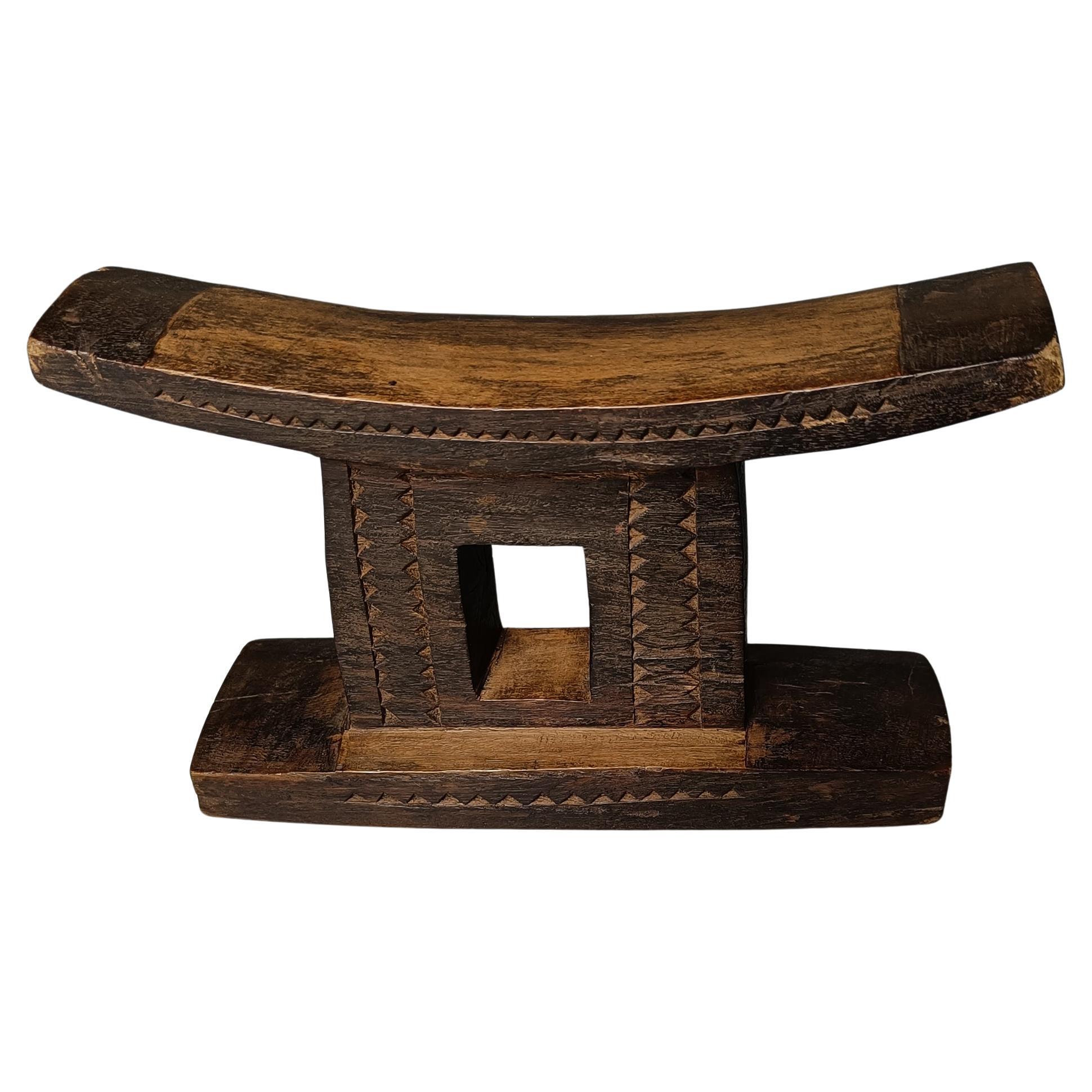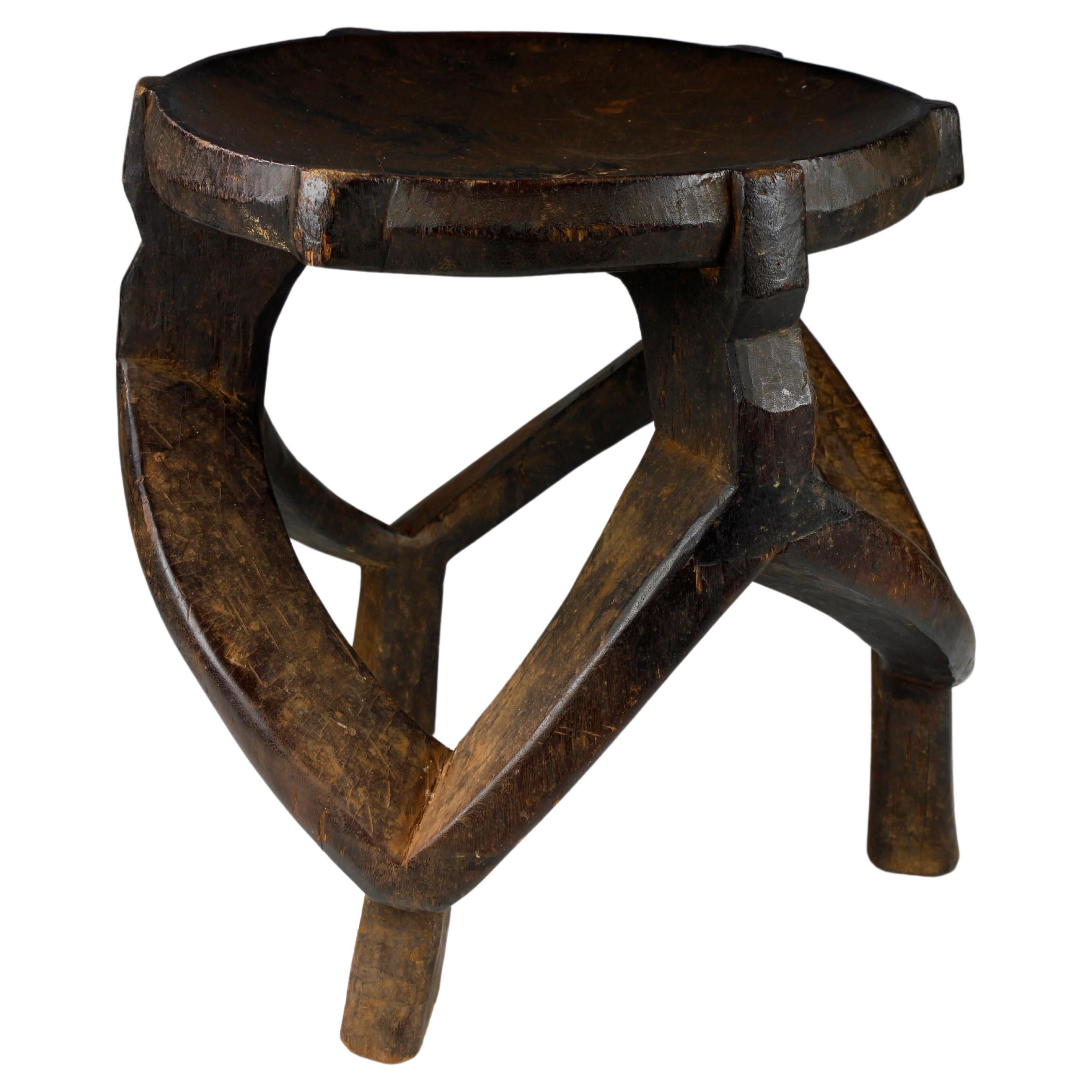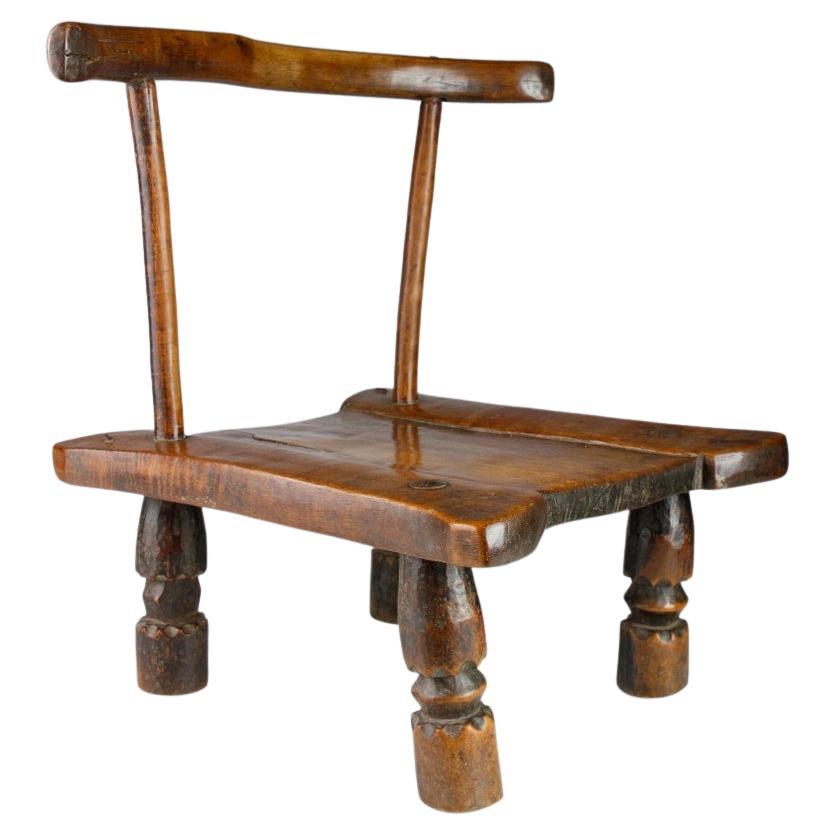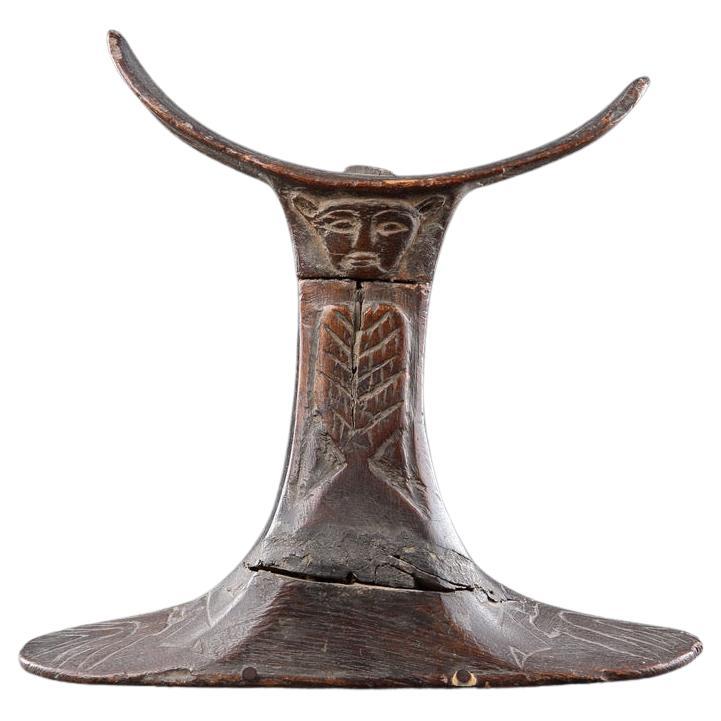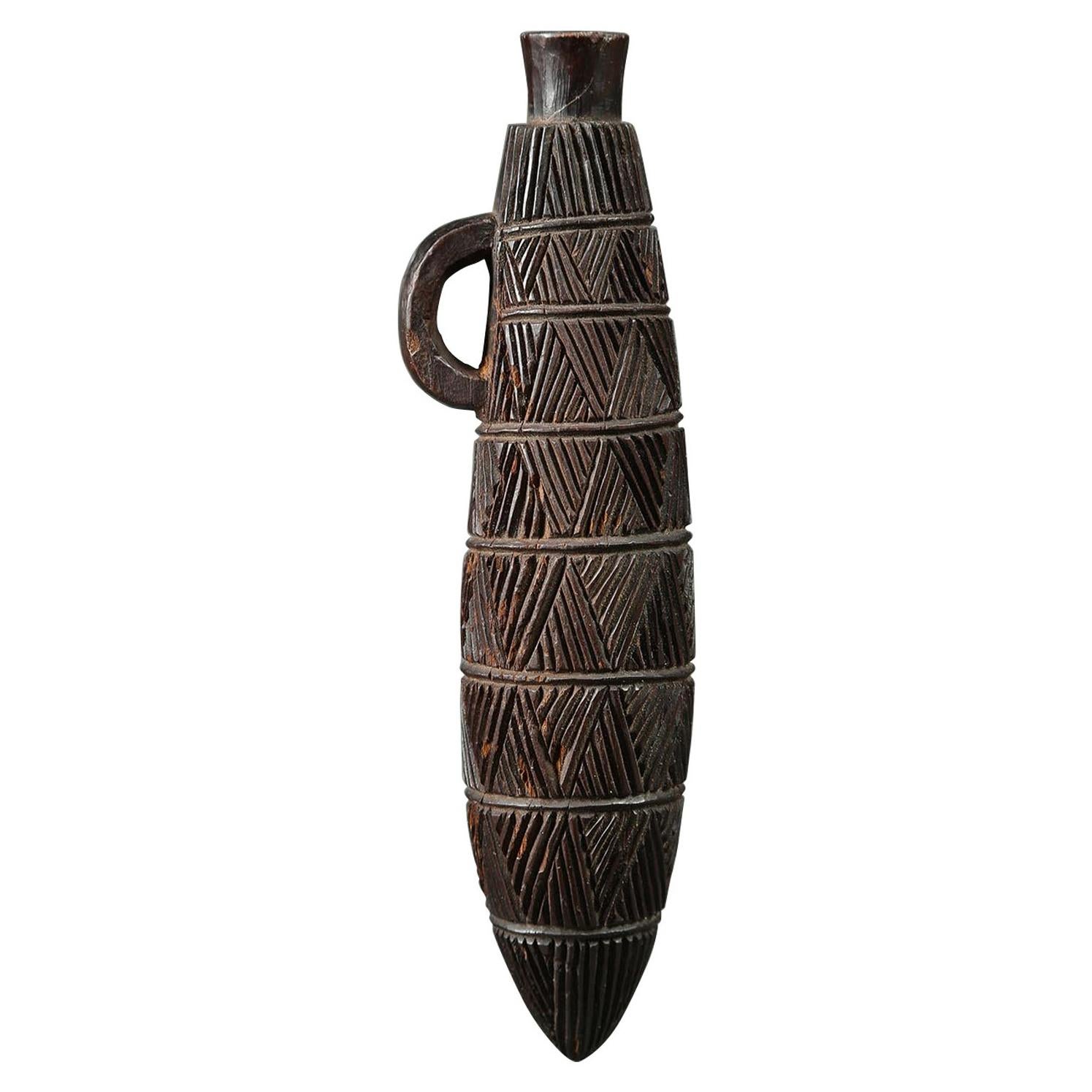Items Similar to A Finely Carved ‘Boni’ Neck-Rest
Want more images or videos?
Request additional images or videos from the seller
1 of 11
A Finely Carved ‘Boni’ Neck-Rest
About the Item
A Finely Carved ‘Boni’ Neck-Rest
Superb dark colour and patination through extended use
Wood
Somalia
19th Century
SIZE: 18.5cm high, 15.5cm wide - 7¼ ins high, 6 ins wide
These headrests are used by nomadic Somali men and women in southern Somalia and north-eastern Kenya. The male type, as in this fine old example, have a relatively small base and are therefore unstable, making deep undisturbed sleep difficult, and enhancing the men’s vigilance in the night. The women’s type have a more stable base.
The extensive Islamic influence in the region is reflected in the guilloche patterning carved on the sides of the headrest which ensures God’s protection for the sleeper.
Provenance:
Ex Susan Montiel-Colmenares, London, circa 1970
Ex Private collection
CF:
Pierre Loos, Bayet et Caltaux, ‘La tête dans les étoiles. Appuis-Nuque d’Afrique et d’ailleurs’, BRUNEAF, 2012: pg. 101
EXHIBITED:
BRUNEAF, Bruxelles, Belgium ‘La tête dans les étoiles’. Appuis-nuque d'Afrique et d’ailleurs’, 6 - 10 June 2012
- Dimensions:Height: 7.25 in (18.42 cm)Width: 6 in (15.24 cm)Depth: 0.5 in (1.27 cm)
- Materials and Techniques:
- Period:
- Date of Manufacture:19th Century
- Condition:Wear consistent with age and use.
- Seller Location:London, GB
- Reference Number:1stDibs: LU9363239430962
About the Seller
No Reviews Yet
Vetted Seller
These experienced sellers undergo a comprehensive evaluation by our team of in-house experts.
Established in 1989
1stDibs seller since 2023
- ShippingRetrieving quote...Ships From: London, United Kingdom
- Return PolicyA return for this item may be initiated within 14 days of delivery.
More From This SellerView All
- A Rare and Finely Carved Egyptian Wooden HeadrestLocated in London, GBA Rare and Finely Carved Egyptian Wooden Headrest with a Carved Head to both Sides Representing the God ‘Bes’ (Protector of the Homestead) above Carved...Category
Antique 15th Century and Earlier Egyptian Tribal Art
MaterialsWood
- A Rare and Exceptional Carved Headrest ‘Kali Hahapo’Located in London, GBA Rare and Exceptional Carved Headrest ‘Kali Hahapo’ Excellent colour and patina Wood, sennet (coconut fibre), glass beads Tonga Late 18th / Early 19th Century SIZE: 19cm high, 5...Category
Antique Early 19th Century Tongan Tribal Art
MaterialsNatural Fiber, Glass, Wood, Coconut
- A Rare Wood Ear OrnamentLocated in London, GBA Rare Wood Ear Ornament With old collectors label ‘Ear Wood. Paraquay’ Wood Paraguay 19th Century Size: 6cm dia., 3.5cm deep - 2¼ ins dia., 1¼ ins deep Published: Steven Phe...Category
Antique 19th Century Paraguayan Tribal Art
MaterialsWood
- A Rare Spirit Mask ‘Barak’ or ‘Yamburai Parak’Located in London, GBA Rare Spirit Mask ‘Barak’ or ‘Yamburai Parak’ Wood, remains of polychrome Eastern Sepik Province, New Guinea Late 19th - early 20th Century SIZE: 45cm high, 35cm deep - 17¾ ins high, 13¾ ins deep Originally these masks were brightly coloured. However, after many years of exposure within the ceremonial houses the colour faded away through use and weathering. The mask was traditionally worn by a dancer whose plant fibre costume completely covered him, and was associated with an important male mythical being. The Barak (sometimes spelled ‘barag’ or ‘brag’) were situated to the west of the Sepik River. The Sepik River was first explored in 1885 by Otto Fisch. He wrote of the regions cultural diversity and beauty of the villages that he saw on the banks of the river over which towered the ‘men’s houses’. In the early 20th century collectors of primitive art were astounded at the sheer quantity of marvellous objects to be found in this region and the extraordinary inventiveness of the forms in this difficult swampy terrain. Provenance: Ex UK Art Market Ex Private collection CF ‘New Guinea Art...Category
Antique Late 19th Century Papua New Guinean Tribal Art
MaterialsWood
- A Very Rare Long Maori Paddle ‘Hoe’Located in London, GBA Very Rare Long Maori Paddle ‘Hoe’ Superb colour and patina Wood Maori / New Zealand Late 18th / early 19th Century Size: 217cm long - 85½ ins long Provenance: W.D. Webster, B...Category
Antique Late 18th Century New Zealand Tribal Art
MaterialsWood
- A South Eastern Congo, Zaire Songye Protective Fetish Figure ‘Nkishi’Located in London, GBA South Eastern Congo, Zaire Songye Protective Fetish Figure ‘Nkishi’ of Geometric Form the arms placed to the side A plug of fetish material in the head cavity a strip of old hide and fur around the waist Old smooth crusted patination 19th Century – Early 20th Century Size: 20cm high – 8 ins high / 29.5cm high, 11½ ins high (including stand) The face of this protective figure is typical of the strong angularity of Songye carving. Amongst the Songye ‘Nkishi’ were associated with a magico-religious society known as ‘bukisi’ which controlled initiation camps and circumcision ceremonies. A shaman would ritually add magical substances ‘bashimba’ to activate the figure as a source of power that would give protection and ensure well-being. Larger figures ensured the tranquillity of the whole community and promoted village fecundity and fertility. Smaller personal or family ‘Nkishi’ were used for protection against illness, sorcery, witchcraft, and war and to promote fertility. Due to their considerable powers the figures were considered dangerous and so they were manoeuvred by means of rods or sticks attached to their arms. They were sometimes made to walk as if on parade. These small half figures were not always used as personal protective devices, but were placed in gourd bowls and used by diviners to communicate with the supernatural world. These divinatory calabash were filled with a number of symbolic objects such as chicken claws, teeth, stones, seeds, etc., as well as carved wooden figures. The Songye’s ritual use of calabash can be compared with the baskets used by the Tshokwe. Provenance: Ex English Private collection Acquired 1950’s Ex Finch and Co...Category
Antique 19th Century Congolese Tribal Art
MaterialsWood
You May Also Like
- African Tribal Art Fine Shona Neck Rest Head RestLocated in London, GBA fine shona head rest neck rest Raised on a single central pillar finely carved with geometric designs Shona Zimbabwe Measures: Height 5 inches, width 6...Category
Antique 19th Century Zimbabwean Tribal Art
MaterialsWood
- African Tribal Art Fine Zulu Neck Rest Head Rest South AfricaLocated in London, GBA fine Zulu head rest neck rest South Africa Raised on central pillars with geometric lozenge shaped carving all over. Measures: 22 x 14 x 5 cm approx. Period Early 20th century Ex U...Category
Antique 19th Century Zimbabwean Tribal Art
MaterialsWood
- Finely Carved Tanzanian Chieftain's StoolLocated in London, GBThis beautifully carved title stool, from the Gogo culture in Tanzania, features a wonderful looped and adjoining structure. Dating back to the mid-twentieth century, this fine examp...Category
Mid-20th Century Tanzanian Tribal Tribal Art
MaterialsWood
- Early Twentieth-Century Finely Carved Small ChairLocated in London, GBThis early twentieth-century small chair displays a beautiful form. Typically low to the ground, such chairs are found among the Dan and Baule cultures in the Ivory Coast. Carved fro...Category
Early 20th Century Ivorian Tribal Tribal Art
MaterialsHardwood
- Zulu Tribal Carved Wood Snuff Container, South Africa Finely Carved IncisedLocated in Point Richmond, CAZulu Tribal carved wood Snuff Container, South Africa A finely carved snuff container with finely carved incised great geometric designs, a great example of the detailed work the Zu...Category
Early 20th Century South African Tribal Tribal Art
MaterialsWood
- Mid-Twentieth Century Finely Carved Food Bowl Depicting Two DucksLocated in London, GBThis fine mid-twentieth-century bowl, from the Lozi culture in Zambia, would have been traditionally used to serve and store food. The bowl's base has been made from a single piece of wood, and two beautifully carved ducks decorate the lid. Animals depicted on Lozi bowls were often species that could be found inhabiting the shores of the Zambezi River...Category
Mid-20th Century Zambian Tribal Tribal Art
MaterialsHardwood

